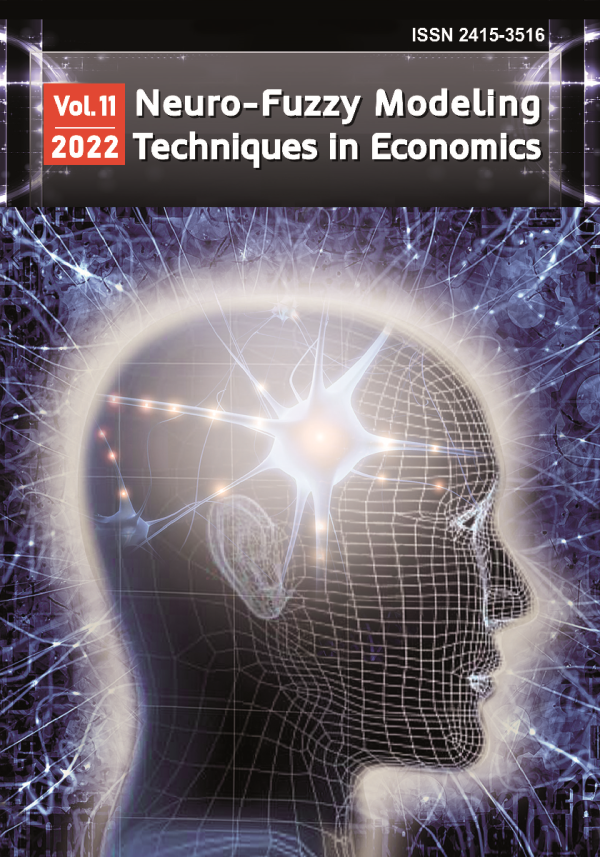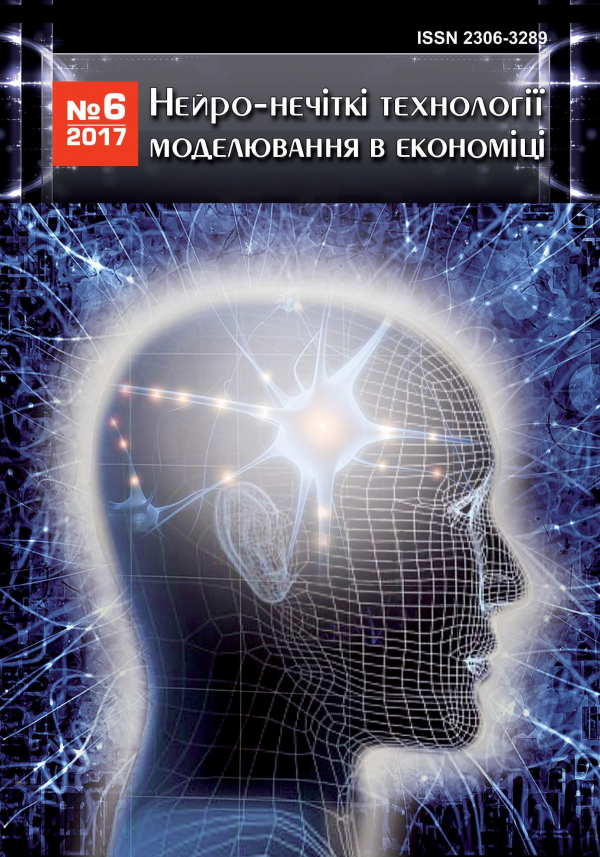
Neuro-Fuzzy Modeling Techniques in Economics
ISSN 2415-3516
Оцінка довіри: теоретичні моделі та результати емпіричного дослідження на прикладі соціальних мереж
Trust evaluation: theoretical models and results of empirical research on social networks
DOI:
10.33111/nfmte.2017.068
Анотація: В умовах переходу до е-суспільства кількість інформації, що генерується щодня, зростає швидкими темпами, при цьому оцінювати її якість і достовірність стає все складніше. Це веде до формування підвищеного попиту на методи та моделі оцінки довіри як до джерел інформації, так і до самої інформації. До поняття довіри останніми роками зверталися вчені з різних наукових сфер – психології, соціології, економіки, інформатики. Однак, незважаючи на зростаючу кількість наукових публікацій у даному напрямку, дослідження залишаються фрагментарними та не дають цілісного уявлення про особливості формування та поширення довіри в суспільстві.
Новий міждисциплінарний напрямок – аналіз даних соціальних медіа, в рамках якого досліджуються профілі та поведінка користувачів онлайнових соціальних мереж, – охоплює такі області як машинне навчання, штучний інтелект, візуалізація даних, алгоритми пошуку інформації, лінгвістика та масштабні обчислення. Беручи до уваги той факт, що користувачами соціальних мереж сьогодні є понад чверть населення планети, соціальні дані представляють собою репрезентативний зріз суспільства та можуть скласти основу для побудови та верифікації моделей оцінки довіри.
Метою дослідження є перевірка теоретичних гіпотез моделей оцінки довіри на основі аналізу поведінки користувачів і структури соціальних мереж. У статті проаналізовано розподіл користувачів, їх повідомлень, друзів і груп, описані нетипові приклади. В результаті кластеризації користувачів ідентифіковані типи їх поведінки: виявлено кластери «письменників», «розповсюджувачів» інформації та її споживачів – «читачів», а також кластер «малоактивних» користувачів. Аналіз кластерів показав, що найчастіше генератори контенту не є основним каналом поширення інформації, що суперечить теоретичним припущенням моделі оцінки довіри. Однак дослідження структури неявних зв’язків між агентами свідчить на користь гіпотези про те, що ті користувачі, які найбільш активно пишуть, мають найбільше число контактів і користуються найбільшою довірою.
Abstract: The amount of daily generated information is growing at a catastrophic rate while assessing its quality and reliability becomes more and more difficult. This leads to an increase in demand for methods and models of trust evaluation both to sources of information and to information itself. Scientists from various fields – psychology, sociology, economics, and computer science – dealt with the concept of trust in recent years. However, despite the growing number of scientific publications in this field, the relevant studies are fragmented and there is not yet a holistic understanding of the topic.
A new interdisciplinary area – Social Media Mining, which studies social networks structures, users’ profiles and their behavior, spans areas such as machine learning, graph mining, information retrieval, knowledge-based systems, linguistics, common-sense reasoning, natural language processing and big data computing. Taking into account the fact that more than a quarter of the world population are users of several online social networks, social data are fully representative cross-section of society and can be the basis for the design and verification of trust models.
The purpose of the study is to examine the theoretical assumptions of trust models based on an analysis of users behavior and the structure of social networks. The article examines the distribution of users, their messages, friends and groups, describes atypical examples. Users clustering allowed identifying the types of their posting behavior: identified the clusters of “writers”, “distributors” of information and its consumers – “readers”, as well as a cluster of “low-active” users. Analysis of clusters showed that content generators are not the main channel for diffusion of information, which contradicts the theoretical assumptions of trust model. However, a study of the implicit relationships structure confirms the hypothesis that “writers” have the largest number of contacts and are most trusted.
Ключові слова: онлайнові соціальні мережі (ОСМ), моделі оцінки довіри, типи поведінки користувачів, карти Кохонена, структура мережі, графові моделі
Key words: online social network (OSN), trust evaluation model, users posting behavior, Kohonen map, network structure, graph model
УДК: 330.47:519
UDC: 330.47:519
JEL: C45 C81 D85
To cite paper
In APA style
Kononova, K. (2017). Trust evaluation: theoretical models and results of empirical research on social networks. Neuro-Fuzzy Modeling Techniques in Economics, 6, 68-89. http://doi.org/10.33111/nfmte.2017.068
In MON style
Кононова К. Оцінка довіри: теоретичні моделі та результати емпіричного дослідження на прикладі соціальних мереж. Нейро-нечіткі технології моделювання в економіці. 2017. № 6. С. 68-89. http://doi.org/10.33111/nfmte.2017.068 (дата звернення: 13.12.2025).
With transliteration
Kononova, K. (2017) Otsinka doviry: teoretychni modeli ta rezultaty empirychnoho doslidzhennia na prykladi sotsialnykh merezh [Trust evaluation: theoretical models and results of empirical research on social networks]. Neuro-Fuzzy Modeling Techniques in Economics, no. 6. pp. 68-89. http://doi.org/10.33111/nfmte.2017.068 [in Ukrainian] (accessed 13 Dec 2025).
 # 6 / 2017
# 6 / 2017
Download Paper
377
Views
134
Downloads
0
Cited by
- Abdul-Rahman, A., & Hailes, S. (2000, January 7). Supporting trust in virtual communities. In Proceedings of the 33rd Annual Hawaii International Conference on System Sciences (pp. 1769–1777). Maui, Hawaii: IEEE. DOI: 10.1109/HICSS.2000.926814.
- Adali, S., Escriva, R., Goldberg, M. K., Hayvanovych, M., Magdon-Ismail, M., Szymanski, B. K., Wallace, W.A., & Williams, G. (2010). Measuring behavioral trust in social networks. In Proceedings of the IEEE International Conference on Intelligence and Security Informatics (pp. 150–152). IEEE.
- Adamiс, L.A., & Huberman, B.A. (2000). Power-law distribution of the World Wide Web. Science, 287, 2115–2115.
- Beatty, P., Reay, I., Dick, S., & Miller, J. (2011). Consumer trust in e-commerce web sites: A meta-study. ACM Computing Surveys, 43(3), 1–14.
- Benevenuto, F., Magno, G., Rodrigues, T., & Almeida, V. (2010). Detecting Spammers on Twitter. Retrieved from http://www.decom.ufop.br/fabricio/download/ceas10.pdf.
- Bumsuk, L. (2012). A temporal analysis of posting behavior in social media streams. Retrieved from http://www.aaai.org/ocs/index.php/ICWSM/ICWSM12/paper/viewFile/4741/5094.
- Buskens, V. (1998). The social structure of trust. Social Networks, 20(3), 265–289.
- Coleman, J. S. (1990). Foundations of Social Theory. Cambridge, MA: Belknap Press of Harvard University Press.
- Dumouchel, P. (2005). Trust as an action. European Journal of Sociology, 46, 417–428.
- Golbeck, J., Parsia, B., & Hendler, J. (2003, August 27–29). Trust networks on the semantic web. In Proceedings of the 7th International Workshop on Cooperative Intelligent Agents (pp. 238–249). Helsinki.
- Gruhl, D., Guha, R., Liben-Nowell, D., & Tomkins, A. (2004). Information diffusion through blogspace. Retrieved from http://people.csail.mit.edu/dln/papers/ blogs/idib.pdf.
- Guo, L., Tan, E., Chen, S., Zhang, X., & Zhao, Y. (2009). Analyzing patterns of user content generation in online social networks. Retrieved from https://cs.gmu.edu/~sqchen/publications/kdd09.pdf.
- Huynh, T.D., Jennings, N.R., & Shadbolt, N.R. (2006). Certified reputation: How an agent can trust a stranger. In Proceedings of the 5th International Joint Conference on Autonomous Agents and Multiagent Systems (pp. 1217–1224). New York.
- Josang, A., & Ismail, R. (2002, June 17–19). The beta reputation system. In Proceedings of the 15th Bled Electronic Commerce Conference (pp. 891–900). Bled.
- Kuan, H., & Bock, G. (2005, May 26–28). The collective reality of trust: An investigation of social relations and networks on trust in multi-channel retailers. In Proceedings of the 13th European Conference on Information Systems (pp. 1–8). Regensburg.
- Kumar, R., Novak, J., Raghavan, P., & Tomkins, A. (2003). On the bursty evolution of blogspace. Retrieved from http://www.disco.ethz.ch/lectures/fs12/seminar/paper/Barbara/32.pdf.
- Lewis, J. D., & Weigert, A. (1985). Trust as a social reality. Social Forces, 63(4), 967–985.
- Liu, H., Lim, E.-P., Lauw, H.W., Le, M.-T., Sun, A., Srivastava, J., & Kim, Y.A. (2008). Predicting trusts among users of online communities: An epinions case study. In Proceedings of the 9th ACM Conference on Electronic Commerce (pp. 310–319). New York.
- Liu, J., Dolan, P., & Pedersen, E. R. (2010). Personalized news recommendation based on click behavior. Retrieved from http://cs.northwestern.edu/~jli156/IUI224-liu.pdf.
- Maheswaran, M., Tang, H.C., & Ghunaim, A. (2007). Towards a gravity-based trust model for social networking systems. In Proceedings of the 27th international conference on distributed computing systems workshops (p. 24). Washington. https://doi.org/10.1109/ICDCSW.2007.82.
- Malik, Z., Akbar, I., & Bouguettaya, A. (2009). Web services reputation assessment using a hidden markov model. In Proceedings of the 7th International Joint Conference on Service-Oriented Computing (pp. 576–591).
- Marsh, S.P. (1994). Formalising trust as a computational concept. PhD thesis. Stirling, UK: University of Stirling.
- Mui, L. (2003). Computational models of trust and reputation: Agents, evolutionary games, and social networks. Retrieved from http://groups.csail.mit.edu/medg/people/lmui/docs/phddissertation.pdf.
- Nepal, S., Sherchan, W., & Bouguettaya, A. (2010, December 13–15). A behavior based trust model for service web. In IEEE Conference on Service-Oriented Computing and Applications (pp. 1–4). IEEE.
- Nepal, S., Sherchan, W., & Paris, C. (2011). STrust: A trust model for social networks. In Proceedings of the 10th IEEE International Conference on Trust, Security and Privacy in Computing and Communications (pp. 841–846). IEEE.
- Papagelis, M., Murdock, V., & van Zwol, R. (2011). Individual behavior and social influence in online social systems. Retrieved from http://www.cs.toronto.edu/~papaggel/docs/papers/all/HT11-Individual-Behavior-and-Social-Influence-in-Online-Social-Systems.pdf.
- Roman, P. E., Gutierrez, M. E., & Rios, S. A. (2012). A model for content generation in On-line social network. Retrieved from https://www.researchgate.net/publication/233897861.
- Rotter, J.B. (1967). A new scale for the measurement of interpersonal trust. Journal Personality, 35(4), 651–665.
- Rousseau, D. M., Sitkin, S. B., Burt, R. S., & Camerer, C. (1998). Not so different after all: A cross-discipline view of trust. Academy Management Review, 23(3), 393–404.
- Sherchan, W., Nepal, S., & Paris, C. (2013, August). A Survey of trust in social networks. ACM Computing Surveys, 45(4), Article 47. http://dx.doi.org/10.1145/2501654.2501661.
- Song, W., Phoha, V.V., & Xu, X. (2004). The hmm-based model for evaluating recommender’s reputation. In Proceedings of the IEEE International Conference on E-Commerce Technology for Dynamic E-Business (pp. 209–215). IEEE.
- Staab, S., Bhargava, B., Lilien, L., Rosenthal, A., Winslett, M., Sloman, M., Dillon, T. S., Chang, E., Hussain, F. K., Nejdl, W., Olmedilla, D., & Kashyap, V. (2004). The pudding of trust: Managing the dynamic nature of trust. IEEE Intelligent Systems, 19(5), 74–88.
- Sztompka, P. (1999). Trust: A Sociological Theory. Cambridge, UK: Cambridge University Press.
- Trifunovic, S., Legendre, F., & Anastasiades, C. (2010). Social trust in opportunistic networks. In Proceedings of the INFOCOM IEEE Conference on Computer Communications Workshops (pp. 1–6). IEEE.
- Tyler, T. R. (1990). Why People Obey the Law. New Haven, CT: Yale University Press.
- Tyler, T. R., & Degoey, P. (1996). Trust in organizational authorities: The influence of motive attributions on willingness to accept decisions. In Trust in Organizations: Frontiers of Theory and Research. (pp. 331–356). Thousand Oaks, CA: Sage Publications.
- Williamson, O.E. (1993). Calculativeness, trust and economic organization. Journal of Law and Economics, 30(1), 131–145.
- Xu, Z., Zhang, Y., Wu, Y., & Yang, Q. (2012). Modeling User Posting Behavior on Social Media. Retrieved from http://yaowu.co/docs/ sigir12.pdf.
- Yu, B., & Singh, M. P. (2000). A social mechanism for reputation management in electronic communities. In Proceedings of the 4th International Workshop on Cooperative Information Agents (pp. 154–165).

